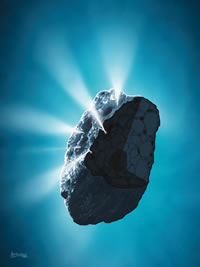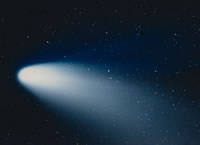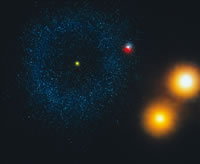[An excerpt:
Comets by Dr. Jason Lisle]
|
 |
|
Interior view of a comet |
|
 |
|
Hale-Bopp comet |
|
 |
|
Artist rendition of the
(purely hypothetical) Oort cloud as seen
from the Alpha Centuri system |
Comets are balls of ice and dirt which orbit the sun,
often in highly eccentric orbits. The solid central
portion of a comet is called the nucleus. Comets
generally have a region of vaporized material
surrounding them which appears as a faint “fog”—this is
called the “coma.” Comets spend most of their time
moving slowly near the point in their orbit that is
farthest from the sun (aphelion). As they approach the
sun, they speed up and slingshot around the sun, moving
fastest at the closest point (perihelion). It is during
these points of close approach that many comets develop
a “tail”—a stream of vaporized material which extends
away from the comet. The tail points away from the sun,
because the material is swept away by solar wind and
radiation. Often two tails develop: an ion tail
consisting of light charged particles, and a dust tail
containing heavier materials. The ion tail is slightly
blue in color; it is straight and points directly away
from the sun. The dust tail is white and is generally
curved. Sometimes only one of the two tails is visible.
A comet’s tail (or tails) is an indication that
comets cannot last forever. The tail means that the
comet is losing material; a comet gets smaller every
time it orbits the sun. It has been estimated that a
typical comet can only orbit the sun for about 100,000
years at most before completely running out of material.
(This is an average figure, of course; the exact life
span would depend on how big the comet is to begin with,
and the parameters of its orbit.) Since we still have a
lot of comets, this suggests that the solar system is
much younger than 100,000 years. This agrees perfectly
with the Bible. Clearly, 4.5 billion years would be an
absurdly inflated age for comets.
How do secular astronomers attempt to reconcile this
with their belief in billions of years? Since comets
can’t last that long, secular astronomers must assume
that new comets are introduced to the solar system to
replace those that are gone, so they’ve invented the
idea of an “Oort cloud.”
This is supposed to be a vast reservoir of icy masses
orbiting far away from the sun. The idea is that
occasionally an icy mass falls into the inner solar
system to become a “new” comet. It is interesting that
there is currently no evidence of an Oort cloud, and
there is no reason to believe in one if we accept the
creation account in Genesis. Comets are consistent with
the fact that the solar system is young.
Source: http://www.answersingenesis.org/articles/tba/age-of-the-universe-2
Footnotes
14.Named after Dutch astronomer Jan Oort. Back
Does Lisle
make a good argument that the universe must be younger
than 100,000 years based on what astronomers know about
comets (dirty snowballs)? Is the "Oort cloud" more
human imagination or science? Which explanation
are you more likely to believe? (Pics).http://vananne.com/serpentdove/Comets.htm
 Comets
Comets


